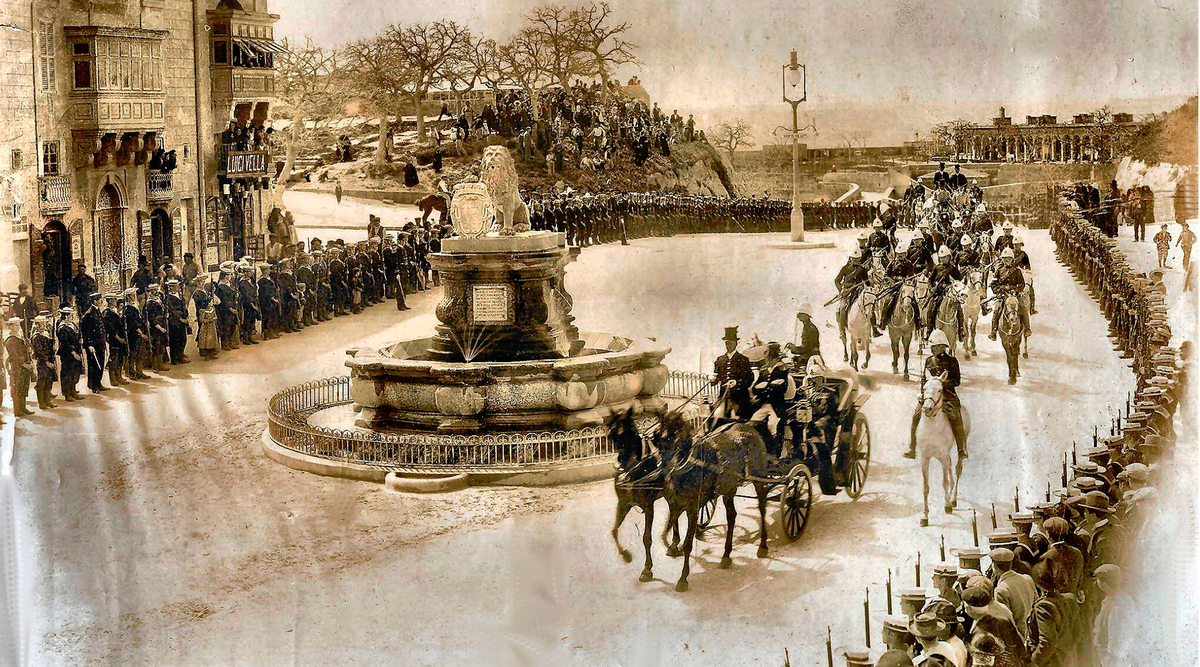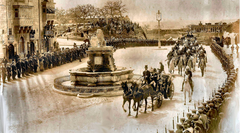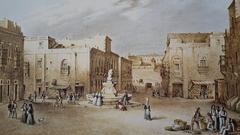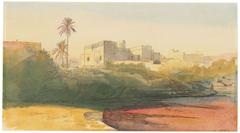
Lion Fountain Gżira Malta Visiting Hours and Tickets
Date: 01/08/2024
Introduction
The Lion Fountain, also known as the Vilhena Fountain, is a captivating Baroque monument located in the heart of Floriana, Malta. This historical landmark, commissioned by Grand Master António Manoel de Vilhena in 1728, stands as a testament to the island’s rich heritage and architectural grandeur (Wikipedia). Situated in St. Anne Square, the Lion Fountain not only enhances the aesthetic appeal of the area but also serves as a symbol of Floriana’s historical and cultural significance. The fountain’s design, featuring a seated lion holding a crowned shield from Vilhena’s coat of arms, underscores its symbolic importance and connection to the Grand Master’s legacy (Waymarking). This guide aims to provide a comprehensive overview of the Lion Fountain’s history, cultural impact, and practical information for visitors, ensuring a memorable experience for anyone exploring this iconic site.
Table of Contents
- Introduction
- History of the Lion Fountain
- Design and Symbolism
- Wartime Preservation
- Post-War Reconstruction
- Modern Recognition and Preservation
- Cultural Impact
- Visitor Information
- Nearby Attractions
- Preservation Efforts
- FAQ
- Conclusion
History of the Lion Fountain
The Lion Fountain, commissioned by Grand Master António Manoel de Vilhena in 1728, was constructed in St. Anne Square, Floriana. It was part of Vilhena’s efforts to enhance the newly established suburb’s infrastructure and aesthetics. The fountain was supplied by water from the Wignacourt Aqueduct, a significant engineering feat of the time, ensuring a steady supply of water to the area (Wikipedia).
Design and Symbolism
The fountain features a seated lion holding a crowned shield, part of Vilhena’s coat of arms. This lion has become a symbol of Floriana, even forming the basis of the town’s coat of arms. The Baroque design includes a basin with a plinth topped by the lion sculpture. Water flows through spouts located in the mouths of sculpted cherubs within the plinth. The fountain also bears a Latin inscription that translates to: “To the increasing population of this suburb, Grand Master Don António Manoel de Vilhena, who holds the inhabitants so close to his heart, decreed that this Fountain is erected – 1728” (Waymarking).
Wartime Preservation
During World War II, the Lion Fountain faced the threat of destruction due to aerial bombardments. To protect it, the lion sculpture was encased in stone and moved to a nearby arcade. After the war, it was temporarily stored in a nearby garage. This careful preservation effort ensured that the fountain survived the war relatively unscathed (Wikipedia).
Post-War Reconstruction
In 1956, the fountain was removed while St. Anne Square was being realigned. Two years later, in 1958, the fountain was reconstructed a few meters away from its original location. The lion was reinstalled on the night of December 31, 1958, to January 1, 1959. This relocation and reconstruction were part of broader urban development efforts in Floriana during the mid-20th century (Waymarking).
Modern Recognition and Preservation
The Lion Fountain has been recognized for its historical and cultural significance. It was included in the 1932 Antiquities Protection List and was scheduled as a Grade 1 national monument by the Malta Environment and Planning Authority on December 22, 2009. This designation ensures that the fountain is protected and preserved for future generations (Wikipedia).
Cultural Impact
The Lion Fountain has not only been a functional piece of infrastructure but also a cultural landmark. It was depicted on a €0.06 postage stamp issued by MaltaPost on March 27, 2013, highlighting its importance in Maltese heritage. The fountain continues to be a popular attraction for both locals and tourists, symbolizing the rich history and architectural beauty of Floriana (Wikipedia).
Visitor Information
Visiting Hours and Tickets
While the Lion Fountain is accessible at any time, the best time to visit is during the early morning or late afternoon when the lighting enhances the intricate details of the fountain. The fountain is illuminated at night, offering a different but equally captivating view. There is no ticket required to visit the fountain.
Travel Tips and Accessibility
The Lion Fountain is located in the heart of St. Anne Square in Floriana, a bustling area with various amenities and attractions nearby. It is easily accessible by public transportation, with several bus routes passing through Floriana. For those driving, parking facilities are available in the vicinity. The area is pedestrian-friendly, making it convenient for visitors to explore on foot. Information signs in multiple languages provide historical context and details about the fountain, enhancing the visitor experience.
Nearby Attractions
While visiting the Lion Fountain, tourists can also explore other nearby attractions in Floriana. These include the Argotti Botanic Gardens, which offer a serene escape with a variety of plant species, and the Floriana Lines, a series of fortifications that provide insight into Malta’s military history. The proximity to Valletta also allows for easy access to the capital’s numerous historical sites, museums, and cultural events.
Preservation Efforts
Ongoing preservation efforts ensure that the Lion Fountain remains in good condition. Regular maintenance is carried out to address any wear and tear, and conservation projects are periodically undertaken to restore and preserve the fountain’s original features. These efforts are crucial in maintaining the fountain’s historical integrity and ensuring that it continues to be a cherished landmark in Floriana.
FAQ
- What are the visiting hours of the Lion Fountain? The Lion Fountain is accessible 24/7, but the best times to visit are early morning or late afternoon.
- Is the Lion Fountain accessible for people with disabilities? Yes, the area around the Lion Fountain is pedestrian-friendly and accessible for people with disabilities.
Conclusion
The Lion Fountain in Floriana, Malta, is a remarkable blend of historical significance, architectural beauty, and cultural heritage. From its commissioning by Grand Master António Manoel de Vilhena in 1728 to its survival through wartime and subsequent preservation efforts, the fountain has remained a beloved landmark for both locals and tourists (Wikipedia). Its Baroque design and symbolic elements make it a must-visit attraction, reflecting the rich history and enduring legacy of Floriana and Malta as a whole. Visitors can enjoy the fountain at any time of the day, with the best experiences often found in the early morning or late afternoon when the lighting accentuates its intricate details. The surrounding area, with its various nearby attractions and amenities, offers a well-rounded cultural experience (Waymarking). As preservation efforts continue, the Lion Fountain remains a cherished monument, inviting visitors to delve into Malta’s storied past and vibrant present.
References
- Wikipedia, 2023 https://en.wikipedia.org/wiki/Lion_Fountain_(Floriana)
- Waymarking, 2023 https://www.waymarking.com/waymarks/WMV03P_The_Lion_Fountain_Floriana_Malta




